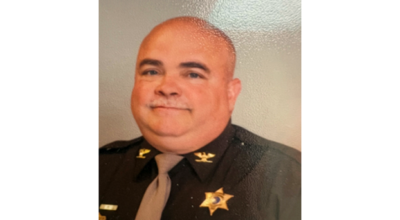Rotary’s ‘Night at the Museum’
Published 10:58 pm Thursday, April 19, 2012

Jeff Dennis of SMC and History 202 student presenters, Misty Christian of Cassopolis, Glen Ditz of Dowagiac and Ashley Wegner of Edwardsburg with Rotary President Barbara Groner Thursday night at the fourth annual Family and Friends dinner meeting, “Night at the Museum.”
Cass County’s role in the Civil War encompasses the 19th Michigan infantry regiment organized in Dowagiac and colored troops who represented 10 percent of the Union Army.
Reporting on that topic for 43-member Dowagiac Rotary Club’s fourth annual Family and Friends dinner meeting Thursday night at Elks Lodge 889 was Ashley Wegner of Edwardsburg. She is a student of Jeffrey Dennis, Southwestern Michigan College social science professor’s History 202 class.
Glen Ditz of Dowagiac handled Dowagiac Manufacturing Co., formerly Dowagiac Drill, which once was the national leader in its industry and employed at least 200, and Misty Christian of Cassopolis on the Underground Railroad in Cass County and the 1847 Kentucky Raid where Quakers resisted slave catchers.
Researchers worked with Steve Arseneau, director of The Museum at Southwestern Michigan College, inspiring the program name, “Night at the Museum.”
Wegner majors in special education and works for Lewis Cass Intermediate School District.
“I love that, but my goal is to change to speech pathology. I will be transferring to the University of Wisconsin-Madison.”
Wegner has so far visited two Georgia battlefields and two in North Carolina.
Ditz, 30, came to Dowagiac at 12 and lives outside town off Peavine Street. He and his wife, who will be graduating from SMC, have a daughter almost 5. He’s looking at Aquinas College in Grand Rapids to pursue a bachelor’s degree in theology with a minor in fine arts ceramics.
Christian recently changed her major to pre-law from medical administration.
Civil War
“I’m very passionate about the Civil War,” Wegner said. “I find it so interesting.”
President Abraham Lincoln issued a call to war in 1861 after the South seceded from the Union. Lincoln wanted 75,000 men to join the Union Army for 90 days to battle the Confederacy.
“It took four years to reunite the nation,” she said.
Joining the 29th regiment of the Michigan Infantry paid $300.
Michigan’s first regiment in May 1861 involved 90,000 men entering the Union Army. Michigan fielded 31 regiments of infantry, 11 regiments of cavalry, 14 artillery batteries, one regiment of sharpshooters and one regiment of engineers. Marcus Gibson of Vandalia joined the 1st Michigan Colored Troops on Aug. 19, 1864.
After seeing action in many battles, he was injured when a barracks collapsed, crushing his left shoulder and collarbone. Gibson spent two weeks hospitalized and later suffered liver and kidney trouble. He was honorably discharged in Charleston, S.C., on Sept. 30, 1865.
“The U.S. Colored Troops made such a huge impact,” Wegner said. “They ended up being 10 percent of the entire Union Army. They started here in Michigan by a letter-writing campaign by Henry Barnes, a columnist in Detroit. Fifty percent of eligible African-Americans in Cass County joined” — about 100.
Dowagiac
Manufacturing
Dowagiac’s “vast history had an effect worldwide,” Ditz said. At the end of the Civil War in 1865, William Tuttle invented a shoe grain drill at a blacksmith shop in Keeler, enabling farmers to plant more ground more quickly. Round Oak Stove’s Philo D. Beckwith also produced a roller grain drill about the same time.
A product was patented on Feb. 5, 1867, giving birth to the Chappell Bros. The factory burned in 1872, and it changed hands to J.P. Warner.
In 1880 came a new machine, a spring-toothed harrow. By 1881, this was Cass County’s first stock company worth $50,000. Mass production and advertising “Dowagiac Drills and Seeders are the Leaders” stretched markets from the Columbian Exhibition in Chicago with early electrical lighting in 1893 to South America, Europe and Asia. By 1910, it boasted the largest drill factory in America.
The company in 1912 hired actor Harry Adonis to push a wheelbarrow to San Francisco from Dowagiac. Another marketing gimmick was a 55-pound, 42-inch man, 27, traveling with two ponies pulling a miniature drill, which resides in SMC’s collection.
In the 20th century, the company experienced financial difficulties as horse-drawn implements gave way to internal combustion engines. Furnace Farm Corp. was its new name in 1923, when it even made water heaters, but having been owned by creditors since 1920, it went bankrupt in 1925.
Underground
Railroad
Quakers organized a secret society in the 1840s that liberated more than 100,000 people. Many former slaves settled in northern states or Canada. Major routes ran through Adrian and Battle Creek, with prominent Cass participants, including Stephen Bogue, Zachariah Shugart, Joel East and Parker Osborn.
More than 100 free blacks lived in Calvin Center. Booker T. Washington visiting Chain Lake.
A spy named Carpenter from Bourbon County, Ky., preceded 13 slave catchers in 1847. They began seeking their “property” in Battle Creek portraying “improved washing machine” salesmen. They went door to door and even wore badges identifying them as “runaway slave catchers.”
Christian told about Erastus Hussey, lead conductor on the Battle Creek line, ordering them to leave and warning Shugart and Bogue. His letter didn’t arrive in time. Slave catchers in Cass captured four “fugitives,” including a woman and a baby. Greeted by angry abolitionists and free blacks, outnumbered Kentuckians surrendered and agreed to appear in court the next morning at nine. Their claim of ownership was denied.
Lawsuits were filed the following year, but they were never received compensation for their lost property.






